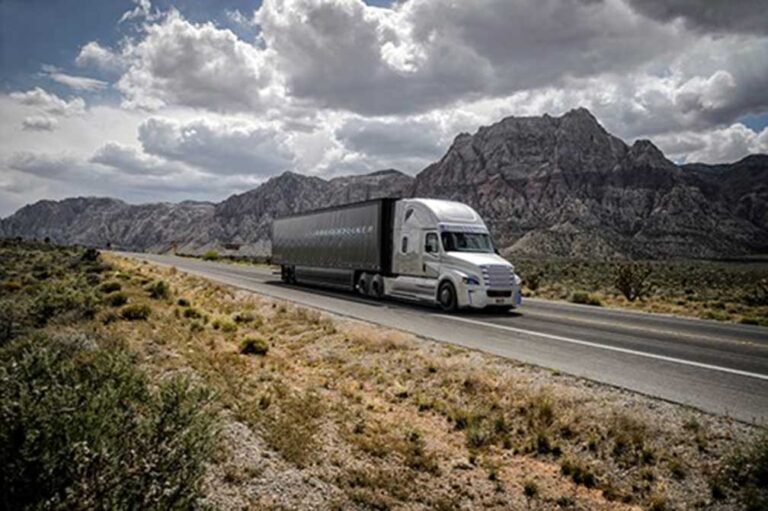These are interesting times in the world of Class 8 truck sales.
Inventory levels at dealers and body suppliers are up, and sales of New Class 8 trucks achieved their best month of the year so far in July. Build levels at the manufacturers are high, and the waiting period for new trucks grew shorter.
At the same time, orders for new trucks fell sharply, expected for this time of year.
The used Class 8 market is bursting at the seams with inventory, prices have dropped, and the available trucks are newer, too.
However, truck loans are harder to come by. Financiers have tightened up lending requirements after experiencing a rash of defaults during the downturn in freight — and when loans are available, interest rates are higher.
Trailer orders have slowed, too. That’s partially due to the season, but sales could also be impacted by financial factors. Publicly held carriers are reporting reduced income for the second quarter, and some companies may be choosing to put available cash towards pre-buying of tractors ahead of the planned changes for emissions standards set for 2027 by the Environmental Protection Agency.
At least some of the blame for stagnant income levels is still aimed at private fleets.
“Private fleets have taken around 6% market share from for-hire carriers since early 2023, leaving the for-hire market swimming in capacity despite rising freight volumes,” said Kenny Vieth, president and senior analyst at ACT Research. “For-hire carrier profitability remained at generationally low levels in Q2’24.”
July stats
In July, a total of 21,398 new Class 8 trucks were reported sold on the U.S. market, according to the latest data received from Wards Intelligence. That’s 18% higher than June sales of 18,134 and — for the first time this year — sales bested the same month of the previous year, by 1.8%.
For the year to date, OEMs reported 134,965 new Class 8 trucks sold on the U.S. That’s down by nearly 22,000 trucks from the first seven months of 2023.
Analysts have been predicting a slowdown in sales for the second half of 2024, but the market has been resilient so far. Part of the reason for that resiliency is undoubtedly sales to private fleets.
Despite current low freight rates, private carriers that were badly burned by record-high spot freight rates in late 2021 and early 2022 are making sure their own fleets have the equipment to handle their product without relying on the spot market. Some are taking spot loads from the market, even at a loss, to keep those trucks busy. At while at the same time, they are now hauling the loads that were previously offered to brokers.
As the freight market starts to recover, truck sales will eventually trend higher, especially as fleets pre-buy in anticipation of the 2027 model year EPA mandates on fuel economy and emissions, as noted previously. With the price of 2027 models expected to increase by $30,000 per truck or more, buyers will be clamoring for 2026 models to beat the increases.
“We expect to see further reductions in backlogs once the final Class 8 market indicators are released later this month, as well as continued growth in an already-record level of inventory. The pressure on OEMs to reduce build rates continues to grow,” Dan Moyer, senior analyst, commercial vehicles at FTR Transportation Intelligence, said regarding the remainder of 2024.
On the used Class 8 market, ACT Research reported that sales in July increased 38% over a slow June and were up 32% from July 2023 numbers. At the same time, the average price of used Class 8 units rose 3% from June but were still 20% under July 2023 sales figures. Average mileage increased slightly while the average age declined.
At Commercial Truck Trader, the numbers were similar. A late July blog posting by Ryan Miller indicated the number of used commercial vehicles listed by the publication increased 37.2% from a year ago while the average price has fallen 20.3%.
“With inventory levels at a six-year high and significant price drops across the board, savvy fleet owners are discovering that now is an exceptional time to invest in used trucks,” said Mac Molli at Jill Schmidt Public Relations, the firm representing Commercial Truck Trader.
With profitability down and a waiting list for new equipment, shopping in the used market may be a favorable option for those who need equipment upgrades.
In July, Freightliner led all OEMs reporting U.S. sales of 7,562 Class 8 trucks, up 24.5% from June and down just 0.6% from July 2023 sales. For the year-to-date, U.S. Class 8 sales have declined 19.9% compared with 14% average for all manufacturers.
OEM performance for July
Daimler-owned sibling Western Star is having a banner year, albeit on a different sales level. July sales of 885 Western Stars were 6.5% better than June’s 831 — but were 30% better than July 2023 sales of 681. Year to date, the company is the only manufacturer running ahead of last year’s pace, with 6,061 Class 8 trucks sold compared to 4,354 at the seven-month mark last year. That’s an increase of 39.2%.
Navistar (International) sales declined sharply in July to 2,290 Class 8 trucks compared to 3,039 in June. Year to date sales of 13,518 represent a 39.1% decline from last year’s 22,184 in the first seven months.
Volvo Truck’s 2,139 units sold in July bested June’s tally of 1,991 by 6.5% and July 2023 sales by 10%. Year to date, Volvo sales lag 8.9% behind last year’s pace — 14,082 compared to 15,541.
Volvo sibling Mack Trucks has seen similar results. With sales of 1,480 Class 8 trucks in July, the company increased sales 8.7% over the 1,362 reported in June. Compared to July 2023, sales rose an even 10%, and the company’s year to date sales of 9,339 are 9.1% behind last year’s 10,278 for January-July.
Peterbilt’s year-to-date sales of 22,163 are a miniscule 42 trucks ahead of last year’s 22,121. Sales of 3,534 in July bested June’s 3,298 by 7.3%. Sales for Paccar sibling Kenworth stood at 3,490, 15.3% better than June’s 3,026. Year to date, Kenworth’s 2,196 is 2.5% behind last year’s 21,745.
Market shares in the U.S. look like this:
- Freightliner — 35.9%;
- Peterbilt — 16.4%;
- Kenworth — 15.7%;
- Volvo — 10.4%;
- International — 10%;
- Mack — 6.9%; and
- Western Star — 4.5%.
The remaining two-tenths belong to Hino, which has sold 111 Class 8 trucks this year.
Cliff Abbott is an experienced commercial vehicle driver and owner-operator who still holds a CDL in his home state of Alabama. In nearly 40 years in trucking, he’s been an instructor and trainer and has managed safety and recruiting operations for several carriers. Having never lost his love of the road, Cliff has written a book and hundreds of songs and has been writing for The Trucker for more than a decade.













